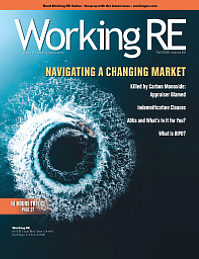 |
> CubiCasa
> OREP E&O |
Long Have Appraisers Been Told
by Tim Andersen, MAI
Long have appraisers heard the advice, “a thick work file is your best defense!” By extension, therefore, a poor work file, a thin work file (or, even worse, no work file at all!) is the prosecution’s best tool against the appraiser. In our case, the prosecution is The State Appraisal Board and their attorney who presents the case to the Board. On the police shows, you’ve heard the arresting officer state solemnly, “Whatever you say can and will be used against you in a court of law!” In our case, what we say (in the report), as well as what we do not say (as in a thin workfile) can and will be used against us. Let’s see how.
Mississippi’s appraisal Board keeps a website (visit WorkingRE.com/MScomplaints) to show its disciplinary actions since 2014. For those nine years, the MAB disciplined twenty-nine (29) appraisers for various infractions of USPAP and/or state statutes. Of these, fully 21 (74%) of them specifically mention the appraiser not having a proper workfile, thus not being able to support adjustments, statements of fact, value opinions, and so forth.
In fact, the general language in all these decisions is:
“[r]espondent does not have verified documentation or analysis to support the information used in the [appraisal] in the appraisal report, in violation of [state statute], [USPAP’s} Record Keeping Rule, Scope of Work Rule (Problem Identification, Scope of Work Acceptability and Disclosure Obligations) and [various] Standards Rules…[and] Respondent did not provide verified documentation or analysis in the workfile for various information stated in the Appraisal Report. [Respondent] provi[ded] a limited workfile and does not have verified documentation necessary to sufficiently analyze the information for the three (3) approaches stated in the appraisal report.”
While the analyses and protocols that went into authoring this article are far from scientific, it is interesting to note just how seriously the state of Mississippi takes the importance of the workfile.
Here is another quote from one of the Board’s decisions:
“Respondent did not provide verified documentation or analysis in the workfile for certain information stated in the Appraisal Report. The work file contains very limited verified documentation. No cost approach documentation is contained in the workfile to show cost approach analysis or conclusions. There is no apparent explanation for the difference in market value concluded… vs. the concluded value for the cost approach… an unexplained…difference in the two values for the respective approaches. There was no verified documentation reflecting the analysis upon which the appraiser concluded site value.”
This statement from the decision, “[respondent] did not provide…analysis in the workfile” is telling. It makes clear that appraisers are to supply not only documentation, but analyses of their verified data to show the process of how and why they arrived at their conclusions and opinions. In other words, just like in high school algebra, the State of Mississippi demands the appraisers in that state to show their work.
One way to support your conclusions, as well as to fortify your workfile, is what our engineering friends call iterations. In simple English, the term iteration means doing something over and over again, usually with one minor change in the process each iteration—until you’re happy with the results of your efforts. One example of this is the time adjustment. To show proper due diligence, you really should have your time adjustment from two independent sources (if not more). This could be the FHFA website and/or your local MLS.
(story continues)
Your iterations would be to change your inputs for each source/iteration until they both begin to center on a small range of results. It is important to understand how vital it is to support each of these iterations in the workfile. It is by keeping them in the workfile that we show not only that we have followed the appraisal requirements of USPAP’s Standard 1, but it also shows that we have not engaged in bias in collecting, verifying, and analyzing the data supporting the final value conclusion. The various iterations the workfile show that we considered all scenarios before reaching a conclusion.
This concept, that of considering all scenarios, shows that there was no bias in the selection of the data, verification of the data, nor in the conclusions we drew from the data.
This is not the place to show how to adjust the comparable sales, nor how to verify the other data. All that information is available elsewhere. It is, however, the place to emphasize, again, that a thick workfile is the appraiser’s best defense. Therefore, an anemic workfile is the prosecution’s best tool to expose a weak appraiser, a non-credible appraisal, and a misleading appraisal report. When it comes to workfiles and what to keep in them, as Josh Walitt, SRA, has said many times, “If you see it as part of your appraisal, save it in your workfile!”
And as one final thought, it is a common question to hear how long should an appraiser keep their workfile. The easy answer is forever. Store it digitally and it costs nothing. This makes it very easy to keep the files forever.
About the Author
Tim Andersen, MAI, MSc, USPAP instructor and CEO of TheAppraisersAdvocate.com, is the instructor of How to Raise Appraisal Quality and Minimize Risk (7 Hours CE) at OREPEducation.org (OREP Members enjoy the course at no cost. Andersen has been in real estate and consulting since 1975 and is an AQB-certified USPAP instructor, USPAP consultant, author, instructor and expert witness. Andersen can be reached at tim@theappraisersadvocate.com.
OREP Insurance Services, LLC. Calif. License #0K99465




